The activities below are designed to introduce how mathematics is used in the day-to-day world around us. Tailored to be fit for GCSE level students, they emphasize learning through activity and demonstration.
We have a selection of demonstrations, activities and lectures for any visiting school, some of which are available off campus and directly in your classroom
Secondary school activities and workshops
- The Great Race (1 hour, KS3/4)
-
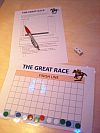 Students will learn about probability and relative frequency in the context of 'The Great Race' - a horse race where the horses move forward depending on the outcome of a dice roll. Students will decide which horses are more likely to win, which horses cannot win, and why. The activity is suitable for KS3 students, either as an introduction to probability, or to reinforce concepts already learned.
Students will learn about probability and relative frequency in the context of 'The Great Race' - a horse race where the horses move forward depending on the outcome of a dice roll. Students will decide which horses are more likely to win, which horses cannot win, and why. The activity is suitable for KS3 students, either as an introduction to probability, or to reinforce concepts already learned. - Networks and Infections (1 hour, KS4/5)
-
 Students will learn about network theory and how this branch of mathematics can be used to understand how infections can spread - and how they can be prevented from spreading.
Students will learn about network theory and how this branch of mathematics can be used to understand how infections can spread - and how they can be prevented from spreading. - The Monty Hall game and problem (1 hour, KS3/4)
-
The Monty Hall problem originates from a TV game show, where contestants have to guess which door a new car is hidden behind and avoid choosing the two doors containing worthless prizes. After the contestant chooses a door, one of the booby prizes is revealed, and the contestant is given the opportunity to select the other door instead. But should they stick with their original choice, or swap? Fortunately, mathematics can advise us on the best course of action! In this practical, students get to play the game and then study the maths behind the puzzle.
- Magical Möbius Strip (1 hour, KS3/4)
-
In this activity you will explore some fascinating surfaces, which can be constructed out of a sheet of paper and learn about their properties.
- Topology & Möbius Strip (1 hour, KS3/4)
-
To give you a better idea of topology, imagine that you draw a circle with a dot inside it on a rubber sheet. No matter how you stretch the rubber sheet, and change the shape, size and measurements of the "circle" the dot will always remain inside the figure. These alterations are called continuous deformations.
- Single & Double Pendulum Motion (1 hour, KS3/4)
-
 In this activity students investigate how length, mass and angular displacement affect the period of a simple pendulum, and how motion of a double pendulum is affected through angular displacement and mass. Students test one variable at a time, using manual techniques (protractor, stopwatch, weights, etc). Data is graphed and compared, to determine what variables affect period (single pendulum), and full revolutions (double pendul um).
In this activity students investigate how length, mass and angular displacement affect the period of a simple pendulum, and how motion of a double pendulum is affected through angular displacement and mass. Students test one variable at a time, using manual techniques (protractor, stopwatch, weights, etc). Data is graphed and compared, to determine what variables affect period (single pendulum), and full revolutions (double pendul um). - The Maths of card tricks (1 hour, KS3/4)
-
There are lots of fun mathematics behind card tricks, and in this workshop students get to discover them first hand!
- Geometric shapes (1 hour, KS3/4)
-
Geometry is an important branch of mathematics, and in this workshop students get to experience the surprising results of geometry first hand.
- Interactive maths puzzles (1 hour, KS3/4)
-
We have a wide variety of maths puzzles available to try out on your students!
- How many? Estimating numbers (1 hour, KS3/4)
-
There are numbers mathematical ways to estimate populations, whether it is of how many aircraft are in the sky at any one time, to the number of tigers left in the wild. Here, we introduce several methods and get students to play out some examples. For example, the Capture-Recapture method can be used for estimating population sizes, and students get to try it out for themselves using ping pong balls in a container!
Round Robin Activities
- Rattleback
-
What you should see is that your rattleback is quite happy spinning in one direction (either clockwise or anticlockwise), but if you spin it the other way, it objects. It will start to rock, and then rattle, and then - amazingly - it'll stop spinning, and simply rock back and forth like a see- saw. If you're lucky, it will even start to rotate the other way.
- Double Pendulum
-
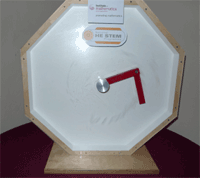 Double pendulum
Double pendulumThe double pendulum is made of a simple pendulum, with another pendulum hanging freely from the first pendulum. The equations which describe the motion of a single pendulum are well defined so it could be easy to make the mistake of thinking that the double pendulum will move in a simple way as well.
- Galton Board
-
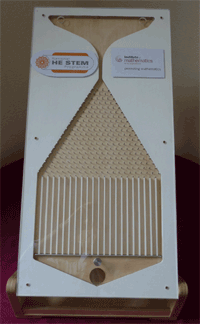 Galton board
Galton boardThe Galton Board (also known as a quincunx or bean machine) was invented by Sir Francis Galton to demonstrate some important concepts in probability. The board consists of a triangular array of pegs. Balls are dropped in at the top and bounce downwards, left and right before being collected at the bottom. If you drop enough balls in, then they will form a bell shaped curve like the one below.
- Soap Wire Bubbles
-
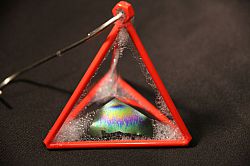 Mathematical minimal surface area bubbles exercise
Mathematical minimal surface area bubbles exerciseDip the wire frames into the soapy liquid and when you put them gently out you should be left with a variety of surfaces which have formed inside the wire.
- Travelling Salesman
-
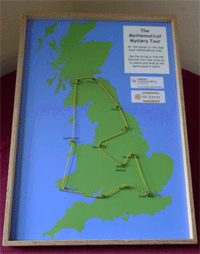 Travelling salesman board
Travelling salesman boardThe travelling salesman problem is a classic problem which has been studied by mathematicians for nearly a hundred years. The problem is simple. A travelling salesman has a number of towns he wants to visit, before finishing where he started out. What is the shortest path he can take? One option would be to try out all possible routes and then compare them to see which is the shortest. This quickly becomes too difficult, with 10 cities there are 3,628,800 possible routes, for 100 cities it would take a computer 40 million years to compare all the routes!


